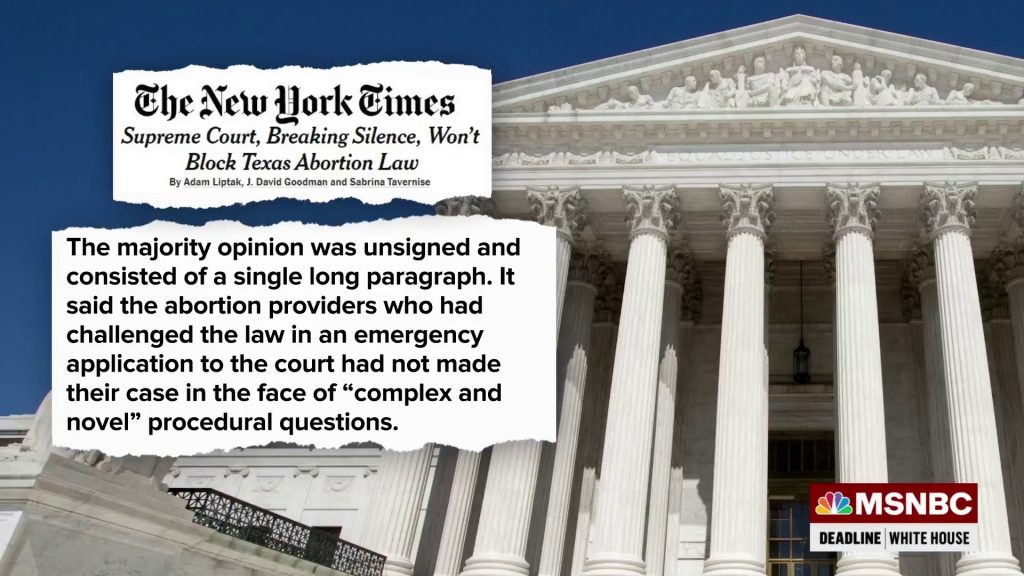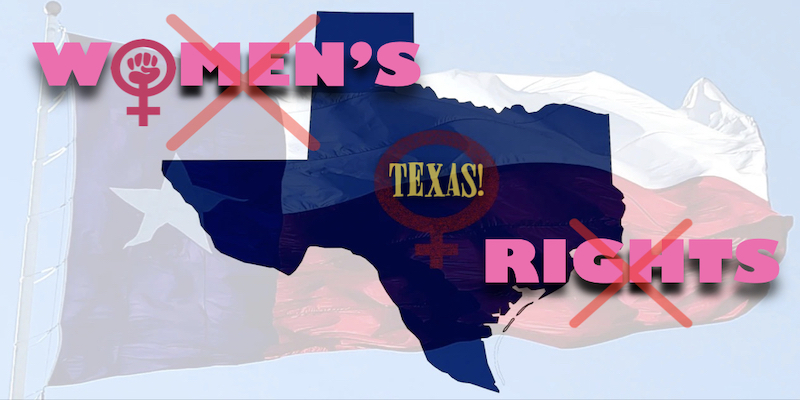If you thought the new Texas abortion law set a dangerous precedent for the Lonestar state, just wait until it starts expanding to other states and soon becomes the law of most of the land.
Top News Today
Last week, the US Supreme Court voted 5 to 4 to uphold a new Texas abortion law that will prevent women in the state from obtaining an abortion for incest, rape, or any reason after only 6 weeks of pregnancy. Since most women are unaware they’re even pregnant prior to 6 weeks, the law will effectively railroad the US standard of Roe v. Wade and make abortions in Texas an unobtainable procedure of the past.

In a stunning battle between a predominately conservative Supreme Court, Chief Justice John Roberts ditched his conservative colleagues and voted along with Justices Stephen Breyer, Elena Kagan, and Sonia Sotomayor in opposing the Texas abortion law. However, thanks to Donald Trump appointees Neil Gorsuch, Brett Kavanaugh, and Amy Coney Barrett (who joined forces with Clarence Thomas and Samuel Alito), they were able to push the law through and put an immediate halt to abortion in Texas.
“The court’s order is stunning,” Justice Sonia Sotomayor wrote in a dissent. “Presented with an application to enjoin a flagrantly unconstitutional law engineered to prohibit women from exercising their constitutional rights and evade judicial scrutiny, a majority of justices have opted to bury their heads in the sand.”
Chief Justice Roberts wrote that he would have preferred to block the law while appeals moved forward.
 “The statutory scheme before the court is not only unusual but unprecedented,” Roberts wrote. “The legislature has imposed a prohibition on abortions after roughly six weeks, and then essentially delegated enforcement of that prohibition to the populace at large. The desired consequence appears to be to insulate the state from responsibility for implementing and enforcing the regulatory regime.”
“The statutory scheme before the court is not only unusual but unprecedented,” Roberts wrote. “The legislature has imposed a prohibition on abortions after roughly six weeks, and then essentially delegated enforcement of that prohibition to the populace at large. The desired consequence appears to be to insulate the state from responsibility for implementing and enforcing the regulatory regime.”
Justice Elena Kagan criticized the court’s practice of deciding important issues in rushed decisions without full briefing or oral argument — or what Supreme Court specialists have called a “shadow docket.”
“Today’s ruling illustrates just how far the court’s ‘shadow docket’ decisions may depart from the usual principles of appellate process,” she wrote. “That ruling, as everyone must agree, is of great consequence.”
So, what does the Supreme Court’s ruling to uphold the controversial Texas abortion law mean for the rest of America?

Since Texas was successful in skirting the current US law which allows legal abortions, watch for other conservative states to seize the moment and use Texas as legal precedent to skirt the law in their state, too. Or, in other words, Alabama, Mississippi, Oklahoma, Missouri, Arkansas, Tennessee, Florida, Kansas, South Carolina, Nebraska, Kentucky, and other conservative strongholds could soon make abortion illegal within their borders for ANY reason. That would not only end a woman’s right to make decisions about her own health and her own body, but it would prompt women to cross state lines or return to the days of “dark alley” procedures in order to end a pregnancy.
And, if that happens, welcome to the DIVIDED States of America!







CNN:
The Supreme Court’s dramatic 5-4 action leaving a Texas abortion ban in place at midnight Wednesday establishes that the Roberts Court no longer is Roberts’ Court.
Chief Justice John Roberts dissented with three liberal justices in what could be regarded as the least considered but most consequential case in years.
Since Justice Amy Coney Barrett joined the court last October and he lost his position at the ideological center of the bench, Roberts has been on the dissenting side in a handful of close cases. But the Texas abortion controversy arguably marked his most significant loss to date.
CNN:
Supreme Court justices tout judicial integrity and the importance of public confidence in their decisions, but the court’s midnight silence Tuesday while letting a Texas law that curtails abortion rights take effect — followed by a midnight order Wednesday — offers the latest and most compelling example of its lack of transparency and the cost.
The justices’ secretive patterns have gained new attention as confidence in all government institutions has waned. Witnesses before a bipartisan commission set up by President Joe Biden to consider court revisions — most visibly, the options of term limits and the addition of more seats — have targeted the justices’ secrecy and how it contributes to public distrust of the high court, along with the lopsided advantage the court gives to some litigants.
Such lack of transparency is only part of the context behind the Supreme Court’s silence in the closely watched Texas case. The emboldened conservative majority already is poised to reverse or at least undercut Roe v. Wade, the 1973 landmark ruling that declared women’s constitutional right to end a pregnancy. The court announced last spring that it would take up in the 2021-22 session a dispute over Mississippi’s ban on abortions after 15 weeks. The Texas law goes much further, making it illegal to terminate a pregnancy when a fetal heartbeat is detected, which may be typically around six weeks.
Both laws sharply conflict with Roe v. Wade, which forbade states from interfering with a woman’s abortion decision before the fetus would be viable, that is, able to live outside the womb, at about 22-24 weeks.
I’m really late getting to this. Couldn’t breathe at all when I woke up this morning due to sinus. Had to take some Benadryl and it knocked me out. Please forgive me if I’m a little “off.” My head’s still not quite clear but it’s getting there.
Okay so when this sorry and tragic news first broke I was, yet again, immediately reminded of Pres. Obama’s simple but very powerful and prophetic words:
“Elections have consequences”
I wonder do young White women in particular truly understand what (mostly) OLD White men (age 50 and older) are in the process of doing to them, state by state?
And I wonder do young White women, in particular, actually care?
I’m also reminded of these words by Maya Angelou:
“When someone shows you who they are, believe them the first time.”
Old White men have been showing Us (the rest of America) who they are since:
1. the day they stepped foot on American soil and decided to simply STEAL this land from the native American Indians thru systematic genocide.
2. the day they implement a system of “Slave Trade.” – whereby Millions of Free Africans, were dragged from their native homes in Africa, packed into ships like sardines and transported across the high seas for the sole purpose using enslaved Africans (and their offspring) as free Slave labor for mostly OLD, wealthy White man in America, Caribbean colonies and Brazil.
Some readers may think I’ve gone way off topic. No I haven’t.
I’m saying LOOK at their history. There is nothing….NOTHING….Old White men won’t do to gain and retain power.
His primary goal in life is have Control over ALL “Others” by any means necessary. Women, Blacks, Hispanics, Asians, Jews, Arabs, Muslims etc. You name it. If you’re not White, Male and “christianist” you don’t count as anything.
If young White women, in particular, aren’t moved to Fight for the right to have control over their own bodies….even in the case of rape and incest…..then Roe V. Wade is already dead.
And Old White men have won.
All I can say is elections have consequences. Trump put his three stooges on the court and now we are paying the price.